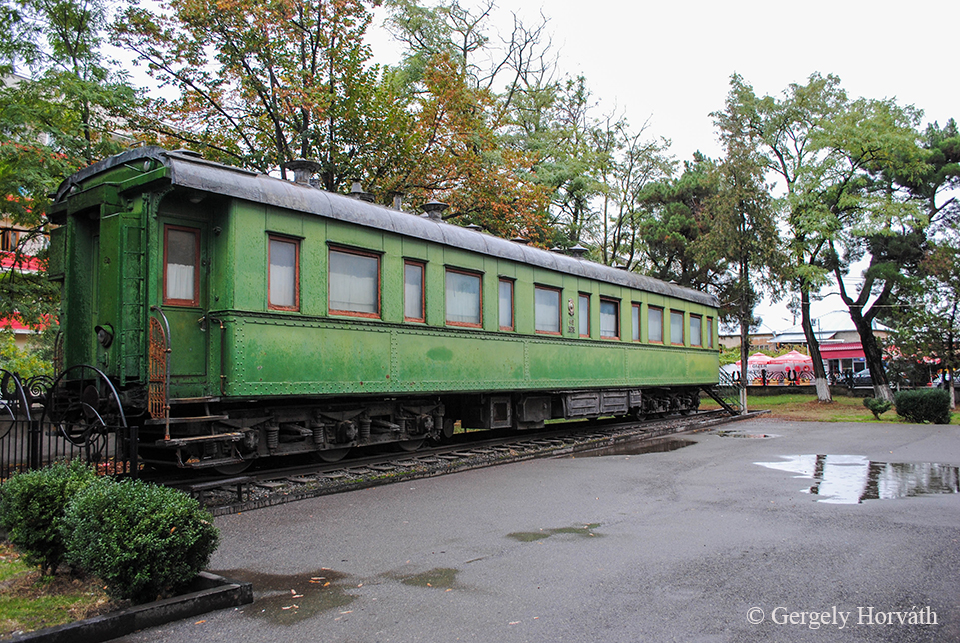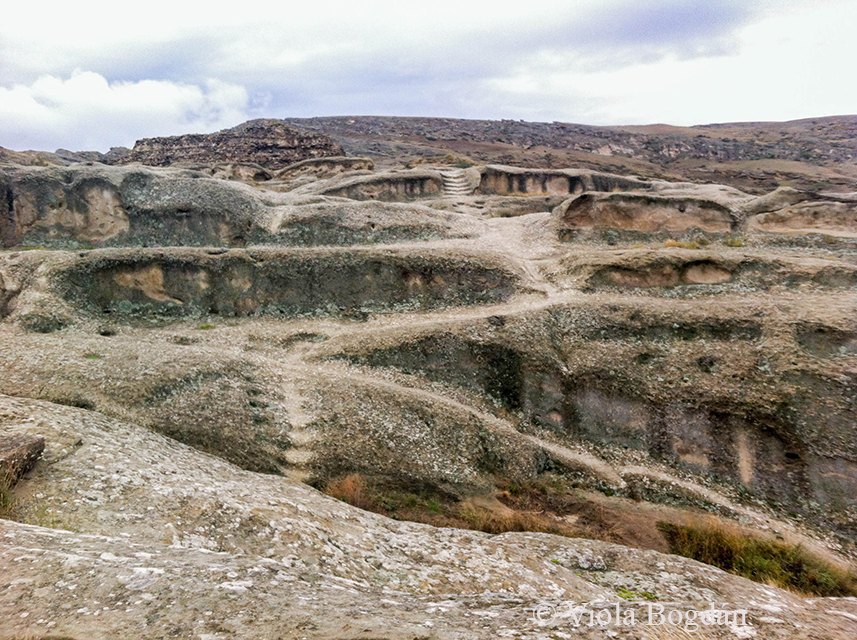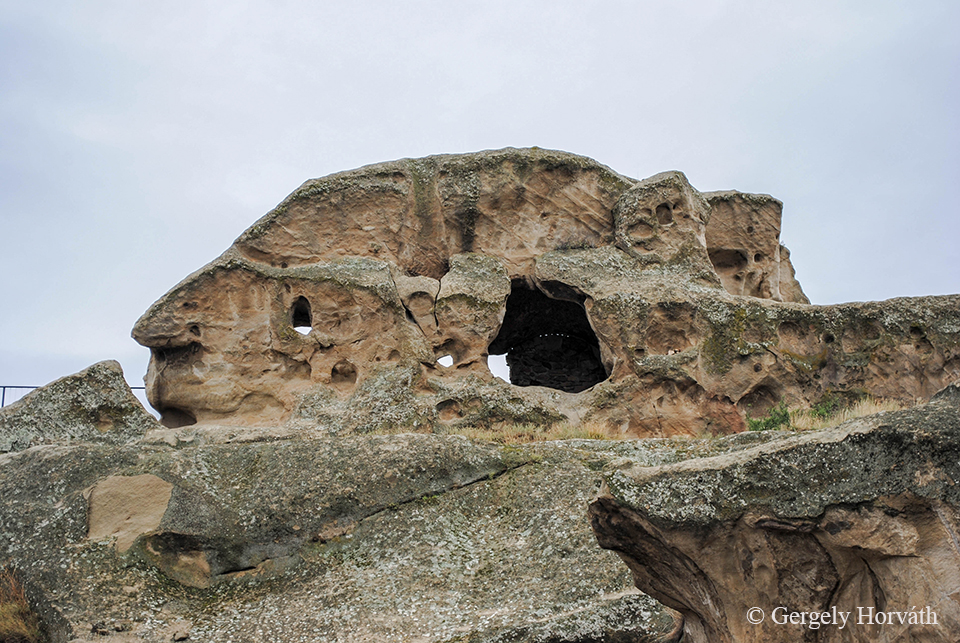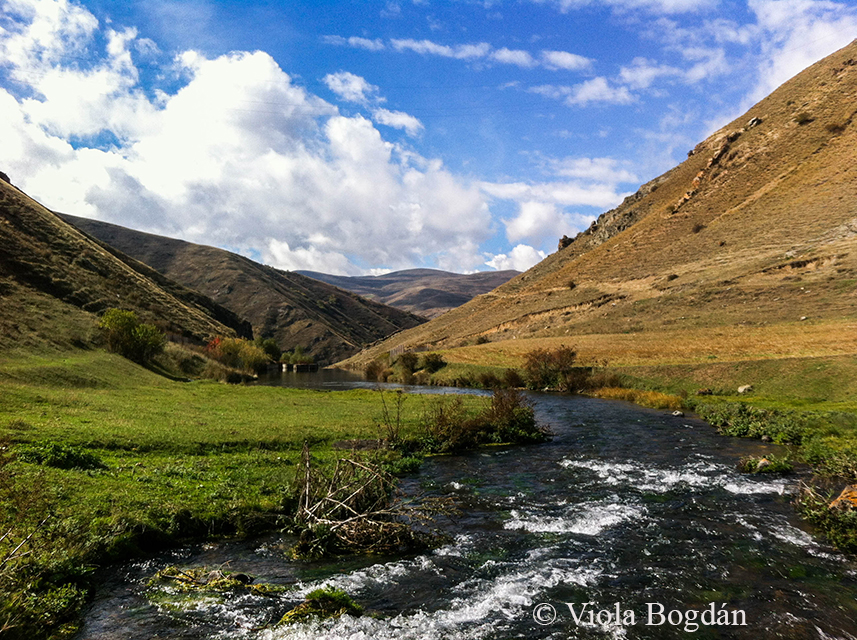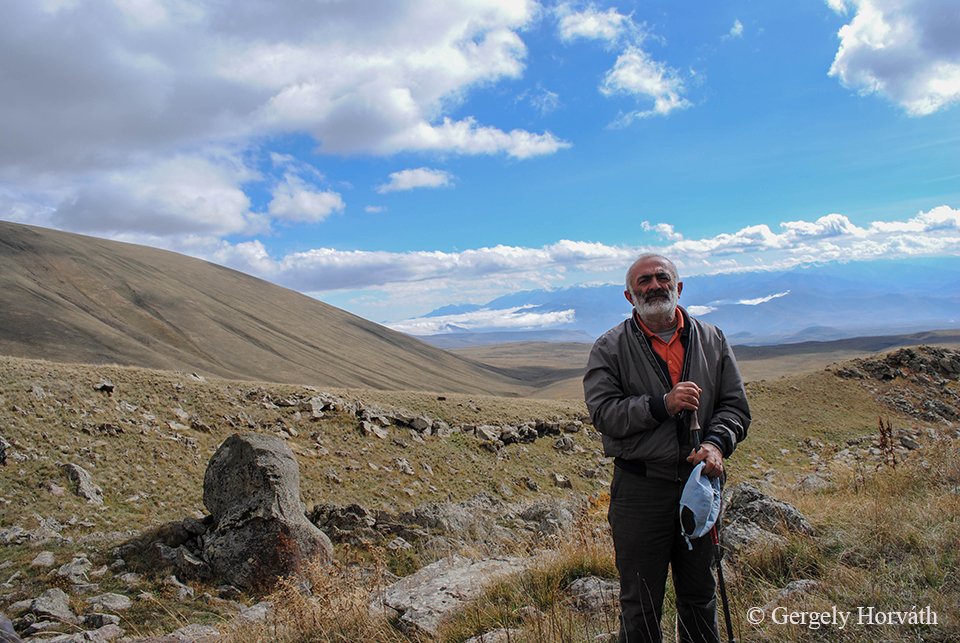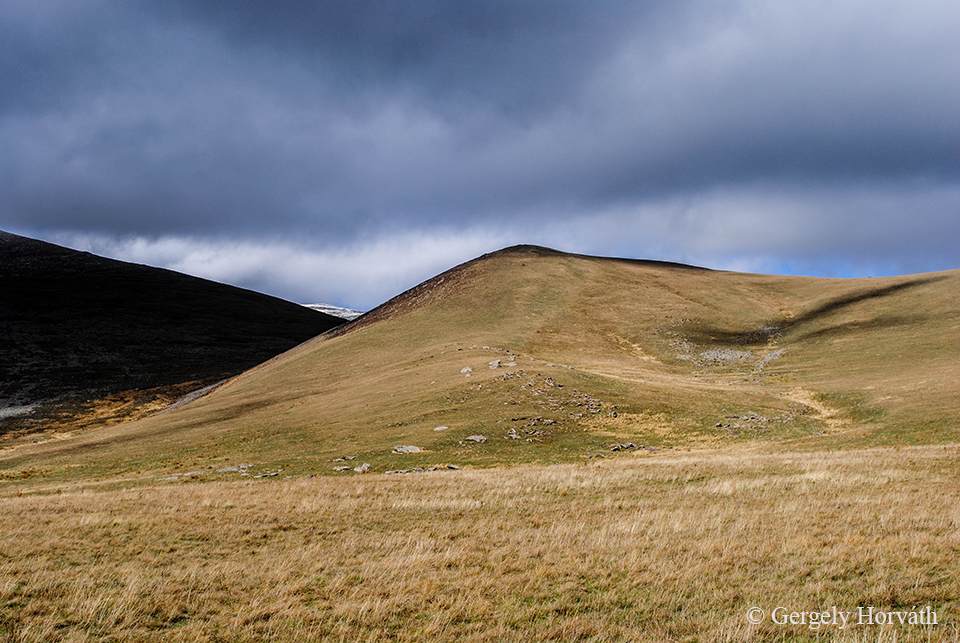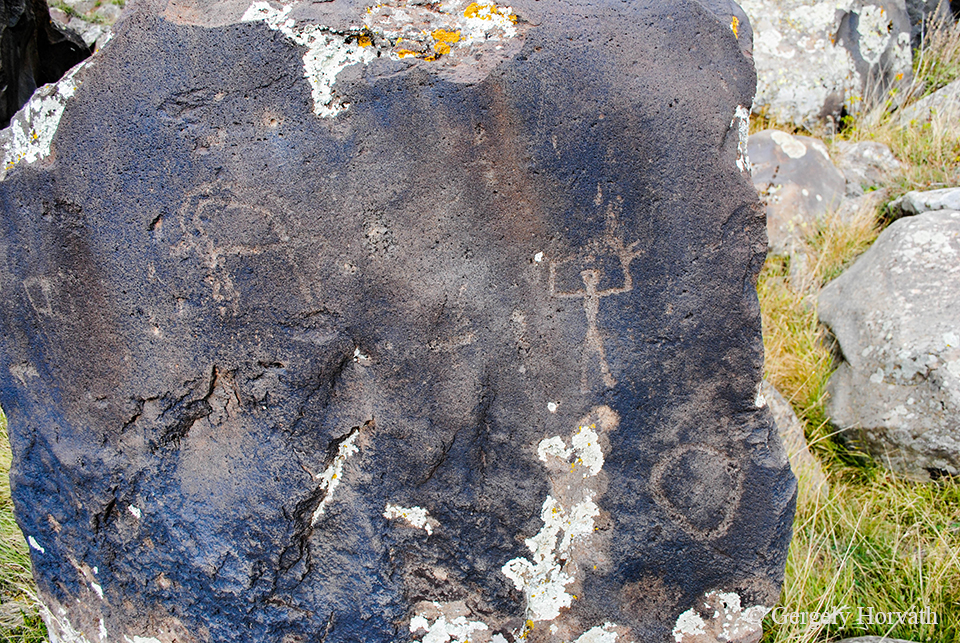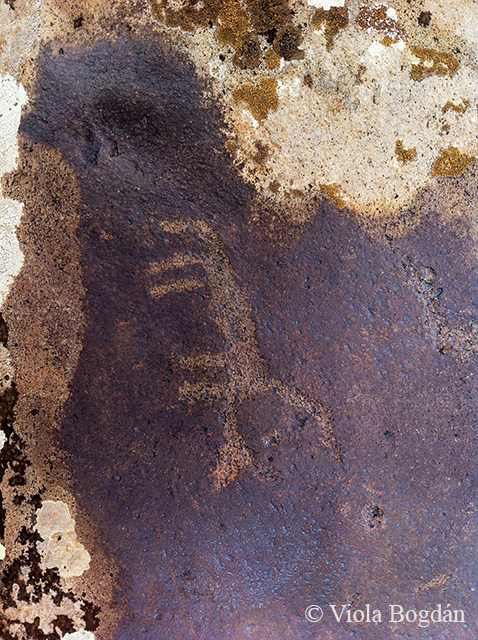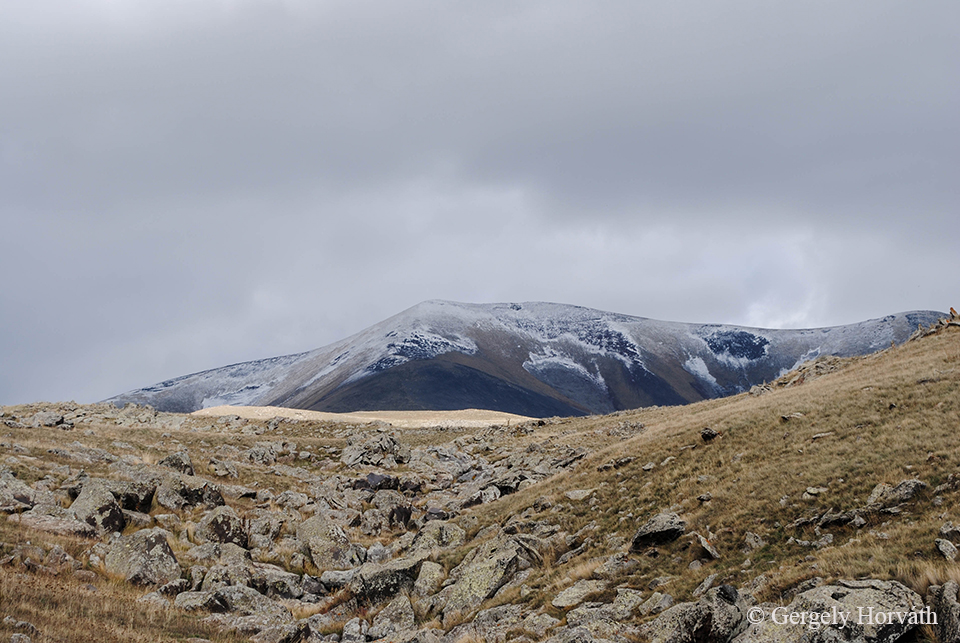Szóval úgy kezdődött, hogy aktuális szállásunkat elfoglalva Goriban, a nagyon kedves házigazda hölgy, Lia szőlővel és teával fogadott minket, és mivel aznap reggel még Jerevánban ébredtünk, az eső pedig egész nap kitartóan esett, örömmel elfogadtuk mindkettőt. Természetesen szóba is elegyedtünk, felvázoltuk másnapi terveinket: körbejárjuk a várost, aztán átruccanunk Upliszcikébe, ha marad még elég időnk, akkor talán még a múzeumba meg a várba is, aztán délután irány Batumi. Így derült ki, hogy a fejemben tökéletesen összeállt, a rendelkezésre álló időt maximálisan kihasználó terv csupán egy ponton hibádzik: Goriból közvetlenül Batumiba csak napi egy busz indul, az is délelőtt fél tízkor. Lia látta tanácstalanságunkat, úgyhogy hamar előállt egy elég használhatónak tűnő, ámbár szokatlan ajánlattal.
The whole story begins at the moment we arrived to our guesthouse in Gori. After we occupied our room, the super nice landlady Lia offered us home raised grapes and hot tea. Since we woke up back in Yerevan and it did not stop raining all day, we gladly accepted both. Of course we started a conversation and we told our plans about looking around in the town tomorrow, then traveling to Uplistsikhe and if we had enough time maybe visiting the Stalin Museum and Goris Tsike. Then on the afternoon we are going to take a minibus to Batumi. As it turned out, my perfect masterplan which fully utilized the available time has only one error: namely that only one marshrutka goes to Batumi per day, at 9.30 am. Lia saw that we became clueless about what to do now, so she quickly offered a quite usable, but also very unusual back-up plan.
„Friends no problem!” Menjünk csak nyugodtan ahova akarunk, járjuk körbe a várost és Upliszcikét se hagyjuk ki semmi pénzért, mert tényleg nagyon szép (az is, mint kiderült). Amikor visszaérünk, ő majd hív nekünk egy taxit, ami kivisz az autópályára (!), a taxisofőrrel pedig megbeszéli, hogy intsen le nekünk egy Tbilisziből Batumiba tartó marshrutkát (!!).Lia arca túl komolynak tűnt ahhoz, hogy csupán helyi tréfának gondoljuk az egészet, na meg nem akartuk, hogy egy egész napunk a levesbe menjen el, úgyhogy hamar ráálltunk. Végül is kaland az élet.
’Friends, no problem!’ she starts. We could go wherever and do whatever we want. Take a look inside the town and we definitely should not miss Uplistsikhe because it’s really amazing (it is, as it turned out). When we finis, all we need to do is coming back and she‘ll order a taxi for us. The driver will take us to the motorway (!) and he will help us to stop marshrutka going from Tbilisi to Batumi (!!). Lia’s face looked way more serious to be joking. In addition, we did not want to waste the whole day on travelling, so we agreed to do the same way she proposed. Life is about adventure after all.
Minden ment is simán, megnéztünk mindent, amit akartunk, visszaérve még ettünk valamit, ittunk egy teát, Lia házi térképén mi is elhelyeztük saját gombostűnket a már meglévő rengetegben és felkészültünk a hadműveletre. A taxis jött is, és Lia, ahogy ígérte, neki is elmondta, hogy mit szeretnénk. Nyilván semmit sem értettünk a beszélgetésükből, de ahogy Lia időnként aggodalmasan ránk pillantott, sejtettük, hogy a taxis nem igazán vevő a pesztrálásunkra, azon kívül, hogy elvisz minket oda, ahova megfizetjük. Megérzésünk be is igazolódott.
Everything went well, we saw all of the must-sees we wanted and when we returned we even had time to eat something and drink a farewell tea. We inserted our pin on Lia’s visitors-map and prepared to the operation. The taxi came and Lia told the guy what we needed. Of course we did not understand a word they said, but the worried look on Lia’s face told me that it won’t be as easy she expected to be. The taxi-driver looked not very open to nursing us besides he drives us wherever we pay him enough for. And as it turned out our intuitions were true.
„Friends, no problem!” Ez nem jelenthet akadályt, hiszen rengeteg kisbusz jár Tbilisziből Batumiba, nekünk csak az a dolgunk, hogy leintsük a megfelelőt, mondta Lia és a kezembe nyomott egy cetlit, amin Batumi neve állt, grúz betűkkel: ბათუმი. Megmondom őszintén, sok akadályon átvergődtünk az idáig vezető időszakban, és mindig optimistán álltunk a dolgok elébe, de ez volt az a pillanat, amikor mindketten kicsit elbizonytalanodtunk a jövőt illetően. Egy idegen kultúrájú ország autópályája szélén, szemerkélésből egyre biztosabb szakadásba kezdő esőben állva az ember elég könnyen el tudja veszteni a jókedvét, de végül is minden kételyünk ellenére jött marshrutka, nem is egy, és volt olyan is, ami ბათუმი-ba ment. Szóval azért kis büszkeséget is érezve írhatom most, hogy ezt is sikerült megoldanunk. A Grúziába utazni vágyóknak mindenképp hasznos információ, hogy itt az autópályán sem lehetetlen stoppolni.
’Friends no problem! This is just a small inconvenience what should not worry us at all! There are many minibuses travelling between Tbilisi and Batumi all we need to do is stop one on its way’ she told and put a paper in my hand with the name of Batumi in Georgian letters on it: ბათუმი. I’ll be honest with you we have been through a lot of unexpected turns during the two weeks and we tried to stay positive the whole time. But this was the exact moment when we both became a bit unsure about the future and this did not really changed standing at the edge of the motorway. In a country with a foreign culture trying to stop a fast moving vehicle while the rain falls harder and harder isn’t the situation what cheers you up. But after all, despite our scepticism one marshrutka really came and we managed to take it to ბათუმი. So after we solved this final task I write now these lines feeling a little pride about what we accomplished. For those who planning to hitchhike in Georgia I can say that it is not impossible even on the motorway.
Batumira rátérve: a város elég feltűnő jelenség lenne, akkor is, ha nem Grúziában lenne megtalálható. Az Adzsár Autonóm Tartomány székhelye jelen pillanatban Grúzia legfontosabb kikötője, de az utóbbi évtizedben elég sok pénzt öltek a turizmus fejlesztésébe, ami főleg felhőkarcolók és kaszinók építését takarja. Mindezzel nem is lenne semmi baj, de a Tbilisziben már megismert posztmodern stílus itt aztán végleg elszabadult és eléggé megkérdőjelezhető ízlésvilággal karöltve formálta ki a város „modern” arculatát. Természetesen már csak hozzáértés hiányában sem bocsátkozhatok megfelelő mélységű elemzésbe, a képek úgy is többet mondanak a szavaknál.
About Batumi: The city would be an eye-catcher even if it hasn’t been found in Georgia. At the moment Batumi is the capital of the Ajarian Autonomous Republic and the most important port of Georgia. During the last decade authorities invested lot to increase tourism in the city. This mainly means building of skyscrapers and casinos. This alone would not be wrong but the postmodern style what we already saw in Tbilisi came totally out of control and together with a questionable sense of taste dominates the ‘modern’ image of the city. In the lack of adequate competence I cannot analyse the phenomenon in depths so I let the pictures tell the story.



A legnagyobb őrültség, amit egész Grúziában találhat az ember: A Csacsa-torony. Pár évvel ezelőtt a városvezetés véghez vitte azt, amit igazából mindenütt meg kellene valósítani, így minden este hét órától tíz percen keresztül pálinka folyik a torony melletti fém kutakból. Nagy bánatomra ottjártunkkor nem működött, mivel nagy esőzések alatt leállítják.
The craziest thing what you can find in whole Georgia: The Chacha Tower. A few years ago the local government accomplished what every other city administration should do so at every 7 pm for 10 minutes chacha (Georgian booze) flows from the metal fountains of this towers. My greatest sorrow it did not worked for us, 'cause they shut it out during heavy rains.

A világ legperverzebb szökőkútja. Nézzétek csak a sziréneket.
The dirtiest fountain of the whole world. Just look at the syrens.



Médeia, kolkhiszi királylány és az aranygyapjú.
Medea princess of Colchis and the Golden Fleece.

A város vadiúj főtere a "Piazza" a velencei Szent Márk teret "mintázza".
The city's brand new main square the 'Piazza' depicts the St. Mark square of Venice



Esténként a belváros neonfénybe öltözik.
Every night the downtown covered in neon-lights.




Az "ABC" torony.
The Alphabetic Tower.


Utunk és beszámolóim is itt végződnek, a Fekete-tenger kavicsos partján. Remélem sikerült sokakban felkeltenem az érdeklődést a Kaukázus és az itt elterülő csodás országok felkeresése iránt. Mi biztosan visszatérünk még.
Our journey and my travelogues ends here at the pebbly beach of the Black Sea. I hope that I could make interest in visiting the Caucasus and the amazing countries of this region in many of you. We will return someday that's for sure.







